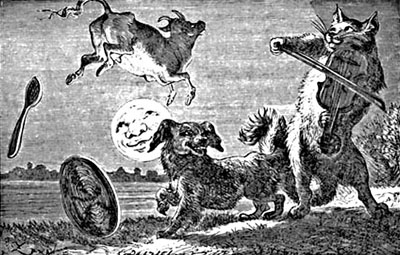 |
||||
 |
 N is for Nursery Rhymes Nursery rhymes have always been one of my favorite things! From the time I was tiny, Old Mother Goose was a big part of my life, passed on regularly to me by parents and grandparents. I loved memorizing the rhymes, and repeating them every chance I’d get. Bed time was a chance to recite “Wee Willie Winkie runs through the town,” while seeing a cow was a chance to rehearse “Hey, diddle, diddle, the cat and the fiddle, the cow jumped over the moon!” Of course, I loved nursery rhymes that were set to music, like “Twinkle, twinkle, little star” and “Three blind mice.”  One of the things that really appealed to me about nursery rhymes was that they told such interesting stories, often ones that took place “far away and long ago” or that were highly imaginative. Having always loved history, as I’d repeat “Ride a cock-horse to Banbury Cross, To see a fine lady upon a white horse; With rings on her fingers and bells on her toes, She shall have music wherever she goes,” I’d picture a fine lady of many centuries past, dressed in long flowing robes, accompanied by men in top-hats and elegant waist-coats, riding along, all bedecked with fine jewelry – and of course all those bells on their shoes and on the horses’ saddles! And that reminds me of another reason I loved nursery rhymes so much; the nursery rhyme books were inevitably decorated with beautiful, colorful pictures, in a day and age when many children’s books were decidedly less colorful! Another great thing about nursery rhymes is that they were so much fun to act out. “Hush-a-bye, baby, on the tree top, When the wind blows the cradle will rock; When the bough breaks the cradle will fall, And down will come baby, cradle and all.” When I was young I’d rock my dolls in my arms as I gently repeated the first lines in a lullaby-soft voice, and at the end of the rhyme, swoop them down to the floor, as I shouted out the last line! Later when I had children, I’d play the same game with them (carefully of course!) and they’d laugh and giggle as they’d “fall.” Of course as soon as I had children of my own, I started teaching them nursery rhymes. It was a great activity as we walked along to the post office, or drove places in the car, or waited for appointments at the doctor’s office. When my oldest daughter, Taryn, started kindergarten, her teacher was amazed at all the nursery rhymes Taryn already knew. And Taryn, too, enjoyed acting out the rhymes. The class had been learning “Jack be nimble, Jack be quick, Jack jump over the candle stick,” and they had been acting it out. Taryn came home, set a candle on the floor, and leaped over it, time and again, shouting out, “Taryn be nimble, Taryn be quick, Taryn jump over the candle stick!” Of course all her younger sisters had to have their turn, too. That little poem kept them entertained for weeks! Nursery rhymes also developed in me a great love for rhyme and rhythm in music. So it wasn’t long before I was also memorizing dozens of songs, especially the old-time Sunday School choruses, and spirituals, and of course many hymns. Later, there would be the number one hits on the hit parade of my teen years, and the folk gospel tunes of the Jesus People movement; and later still the new contemporary worship songs. My parents, both teachers, loved to travel during school holidays, and on the long road trips – one summer we drove all the way across Canada and back – we would memorize scripture, especially Psalms. And in those days, Bible verse memory was also an important part of Sunday School, Bible Camp, Christian Kids’ Clubs, and so on. It didn’t hurt that they usually gave out prizes to the children who memorized the most! I was motivated! When I started school, our teachers immediately started us memorizing poetry, a whole new and exciting world. I remember so clearly in grade two, memorizing two poems, “The Steam Shovel,” and “The Owl and the Pussy-cat.” Not only did we memorize, but our teacher entered us in the annual community “music festival” in the choral speaking contest, and our class took first place. More motivation! Another teacher in those early years introduced us to Robert Louis Stevenson. “Dark brown is the river, golden is the sand…” How those words worked their way into my soul. As I memorized the poem, my imagination was enriched, as I myself sailed down that dark river, under the trees, through the changing landscapes, and finally out to sea, where an unending, mysterious world awaited me. I was brought up far from the ocean, but years later when I would live by the sea, I would wander along the beaches, looking out across the gray choppy waters stretching into the mists of the horizon, and that poem would come back to me, and once again I would set sail. And then of course there was “Oh I do love to go up in a swing...,” and “In winter I get up at night, and dress by yellow candle light; In summer quite the other way, I have to go to bed by day...,” and even the “world of counter-pane.” Oh how I loved those old-time word pictures, and yet how much I could also relate to them in the here and now. Later, in high school, we memorized Lady MacBeth’s “Out, out foul spot” and other famous passages from Shakespeare, and in English Literature 12, a whole new world was opened as we studied and memorized everything from Beowulf and the Canterbury Tales, through Middle English ballads, the great 16th century poets like Edmund Spenser and of course more Shakespeare, John Donne and Milton in the 17th century, the Romantic poets – how can I even start naming them all? – , and then the writers of the Victorian age like Tennyson and the Brownings, and finally the tragic poets of the early 20th century, many of whom lost their lives in the Great War. I was entranced to discover that amazing poetic form, the sonnet. I loved that course so much, that I took English literature again the next year, in college, as well as studying Canadian literature, and later literature from around the world, and all the time memorizing more and more, although by that time it suddenly seemed out of fashion for teachers to require memorization. But I was hooked already on the joy of words, of poetry, of rhyme and rhythm. Bits and pieces would catch my ear, grab my heart, enrich my imagination, and I’d memorize just for the joy of it. As my children were growing up, and we were walking along, or driving along, I would find myself constantly quoting bits and pieces of these treasures buried deep inside me, whether they were songs or poems – or even proverbs, quotes from novels, bits of famous speeches, or whatever! My kids would laugh and say, “Mom, you have a quotation for absolutely everything!” And then they, too, began to dive into the amazing world of words and rhythm. And now I hear my daughter quoting poetry and song and more to her child. I smile. I do so love nursery rhymes! Norma Hill Date: May 16, 2007 |
 My name is Norma. I'm married to Lionel. We have 5 kids - Taryn, Sarah, Robyn, Wendy and Peter, and one grandchild, Tony. At the moment, I am teaching French and Home Economics at a Christian School. I also enjoy writing, reading, facilitating Christian study groups, exercise, gardening, playing guitar, and a multitude of other interests.
I hope you will find some stimulating ideas here, and I'd love to hear your reactions and thoughts too... leave a note in the Guest Book, or email me.  |
||
| Web Design by Taryn | ||||









